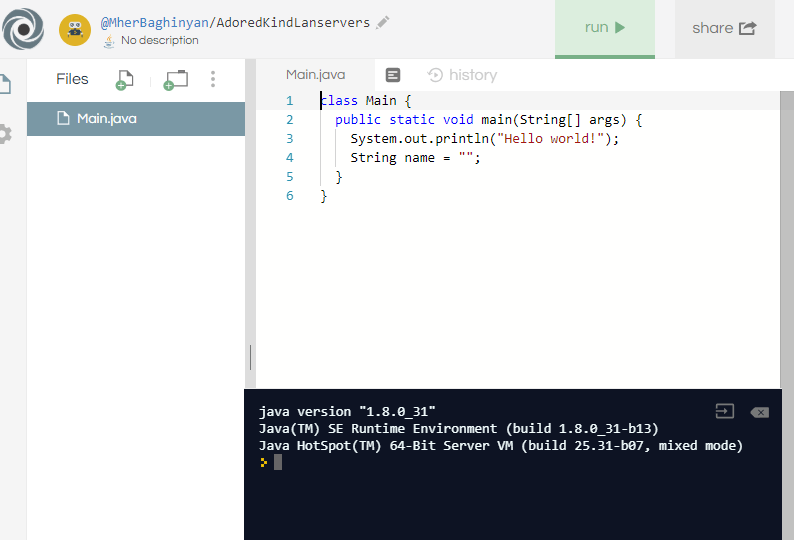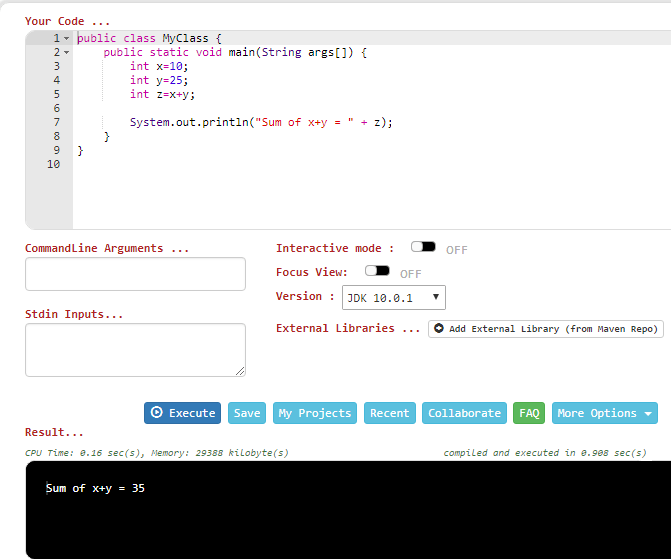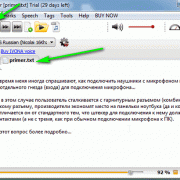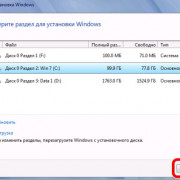Компиляция в java
Содержание:
Extract AST Data
We can get an AST generated by the Java compiler through the TaskEvent.getCompilationUnit(). Its details can be examined through the TreeVisitor interface.
Note that only a Tree element, for which the accept() method is called, dispatches events to the given visitor.
For example, when we execute ClassTree.accept(visitor), only visitClass() is triggered; we can’t expect that, say, visitMethod() is also activated for every method in the given class.
We can use TreeScanner to overcome the problem:
In this example, it’s necessary to call super.visitXxx(node, value) to recursively process the current node’s children.
Plugin Lifecycle
A plugin is called by the compiler only once, through the init() method.
To be notified of subsequent events, we have to register a callback. These arrive before and after every processing stage per source file:
- PARSE – builds an Abstract Syntax Tree (AST)
- ENTER – source code imports are resolved
- ANALYZE – parser output (an AST) is analyzed for errors
- GENERATE – generating binaries for the target source file
There are two more event kinds – ANNOTATION_PROCESSING and ANNOTATION_PROCESSING_ROUND but we’re not interested in them here.
For example, when we want to enhance compilation by adding some checks based on source code info, it’s reasonable to do that at the PARSE finished event handler:
Repl.it
Repl.it has an interactive programming environment supporting many languages. Also, we can create a simple web project including HTML and JS files to practice basic web skills. Its very popular among teachers, interviewers, universities, and colleges.
First of all, we need to sign up on the platform. It is worth mentioning that this requirement doesn’t exist in any of the previously listed compilers:

One important feature is a built-in version control which allows to save the current work, work with the session later, or compare the changes with each version.
Additionally, it has a multi-functional terminal emulator, provides with the rich API and code sharing/collaboration tools, third-party library support.
JDoodle
JDoodle is an easy and quick way to compile and run source code in many programming languages including Java. Even more, JDoodle provides a terminal to work with MySql and MongoDB, peer programming tools, an API to execute code remotely, and an embedding feature for a blog or website.
Its UI has a user-friendly editor and input fields including:
- Command line arguments
- Interactive mode
- JDK versions 8 to 10 are available
- Attaching external libraries directly from the Maven repository. All we need is to specify the group, artifact ids and the version of the library.

Additionally, we can open, save, and download the source file.
Furthermore, the tool displays the compilation and execution along with CPU time in seconds. The memory usage is shown in kilobytes.
Important to note, that JDoodle allows having only one file. So it isn’t the best choice for multiple package projects or learning programming concepts like encapsulation and inheritance.
Testing the Plugin
We need to be able to test our plugin. It involves the following:
- compile the test source
- run the compiled binaries and ensure that they behave as expected
For this, we need to introduce a few auxiliary classes.
SimpleSourceFile exposes the given source file’s text to the Javac:
SimpleClassFile holds the compilation result as a byte array:
SimpleFileManager ensures the compiler uses our bytecode holder:
Finally, all of that is bound to the in-memory compilation:
After that, we need only to run the binaries:
A test might look like this:
Here we’re compiling a Test class with a service() method that has a parameter annotated with @Positive. Then, we’re running the Test class by setting a double value of -1 for the method parameter.
As a result of running the compiler with our plugin, the test will throw an IllegalArgumentException for the negative parameter.
Introduction To Java IDE
Java is one of the popular and powerful programming languages as well as a platform. It is a high level and secured programming language that is used across several platforms in the world like Web applications, Android, Big Data, Banking Domain, Information Technology, Financial Services, etc.
To implement Java programming language we need certain environments where the user can develop codes and applications. Here comes the role of Java Integrated Development Environment (Java IDE). The need for Java IDE was felt as developers were facing issues while coding a huge application.
Huge applications will have a lot of classes & files, and thus, it gets difficult to debug them. With IDE, proper project management can be maintained. It provides hints on code completion, syntax errors, etc.
The Integrated Development Environment (IDE) is a software application that provides developers a platform with many features & facilities to develop Computer applications, Web pages, Tools, Services, etc.
The IDE tool will include text editors, debuggers, compilers, some features, and tools that will help in automation, testing and analyzing of an application development flow.
In simple terms, IDE allows developers to convert their logical code into some useful software applications.
Working Principle Of IDE
IDE follows a simple working principle that allows the developers to write logical code in its environment editor. Its compiler feature tells where all the errors are. The debug feature helps to debug the complete code and rectify errors.
Lastly, it helps in automating some parts and also assists to build a whole new software application. It is capable of supporting Model-Driven Development as well.
Core Functions Of IDE
- IDE should possess code completion capability for identifying the Java language functions and keyword.
- It should have strong resource management that helps to identify missing resources, headers, libraries, etc.
- A good debugging tool to test the developed application completely.
- Compile and build features.
Advantages:
- IDE takes very minimal time and effort as the entire concept of IDE is to make development easier and faster.
- It follows certain company standards, hence the working principle will be the same throughout and helps the coders.
- It comes with good project management tools and documents to automate many things.
- Useful in simplifying the development of database applications.
- It has features to develop a good user interface with text boxes, buttons, etc.
Disadvantages:
- IDE comes with a complex learning curve, thus having some expertise on these tolls will not be easy.
- It is not capable to remove bad code, design, and errors on its own. So the developer needs to be very careful while coding.
- It requires more memory as it uses the graphical user interface.
- It also has a restriction to interact with the database directly.
How To Select A Java IDE
Deciding which IDE or editor suits our needs depends on various factors including the nature of the projects or applications being developed, the process used by the development team, individual-level and skills as a programmer as well as the role in the organization.
Personal preferences and standardization of tools also play an important part in the selection of IDE or editor.
The major advantage of using an IDE for development is when a compiler is integrated with IDE, we get the entire package at one place so that we can complete the code, compile, debug, and execute the program in the same software.
IDEs have an attractive user interface and come packaged with all the elements of software development that we can use to develop software applications.
In this tutorial, we will discuss some of the IDE used for Java development along with the Compilers/IDEs that we can use for Java programming. For developing server-side Java applications, we use three IDEs often i.e. IntelliJ IDEA, Eclipse, and NetBeans.
We will review these three IDEs along with a few other popular ones.
Java Programs
| Java Basic Programs |
|---|
| Java Program to Add two Numbers |
| Java Program to Check Even or Odd Number |
| Java Program to add two binary numbers |
| Java Program to add two complex numbers |
| Java Program to Multiply two Numbers |
| Java Program to check Leap Year |
| Java Program to check whether input character is vowel or consonant |
| Java Program to calculate compound interest |
| Java Program to calculate simple interest |
| Java Program to find quotient and remainder |
| Java Program to calculate power of a number |
| Java Strings Programs |
|---|
| Java Program to Convert char to String and String to Char |
| Java Program to find duplicate characters in a String |
| Java Program to check Palindrome String using Stack, Queue, For and While loop |
| Java Program to sort strings in alphabetical order |
| Java Program to reverse words in a String |
| Java Program to perform bubble sort on Strings |
| Java program to find occurrence of a character in a String |
| Java program to count vowels and consonants in a String |
| Java Arrays Programs |
|---|
| Java Program to Calculate average of numbers using Array |
| Java Program to Add the elements of an Array |
| Java Program to reverse an array |
| Java Program to sort an array in ascending order |
| Java Program to convert char Array to String |
| Java Program to Add Two Matrix Using Multi-dimensional Arrays |
| Java Recursion Programs |
|---|
| Java Program to Reverse a number using for, while loop and recursion |
| Java Program to check Palindrome string using Recursion |
| Java Program to Reverse a String using Recursion |
| Java Program to find Factorial of a number using Recursion |
| Java Programs on Numbers |
|---|
| Java Program to display first 100 prime numbers |
| Java Program to display prime numbers between 1 and 100 or 1 and n |
| Java program to break integer into digits |
| Java Program to check Prime Number |
| Java Program to check if a given number is perfect square |
| Java Program to find square root of a number without sqrt method |
| Java Program to print Armstrong numbers between a given range |
| Java Program to Find Sum of Natural Numbers |
| Java Program to check if a number is Positive or Negative |
| Java Program to generate Random Number |
| Java Program to check Armstrong number |
| Java Program to find GCD of two numbers |
| Java Program to find Largest of three numbers |
| Java Program to swap two numbers using bitwise operator |
| Java Program to find smallest of three numbers using ternary operator |
| Java Program to find largest of three numbers using ternary operator |
| Java Program to display alternate prime numbers |
| Java Program to display even numbers from 1 to n or 1 to 100 |
| Java Program to display odd numbers from 1 to n or 1 to 100 |
| Java Program to Find average of 3 numbers |
| Java Program to Find HCF and LCM of Two Numbers |
| Java Input/Output Programs |
|---|
| Java Program to read number from Standard Input |
| Java Program to Get IP Address |
| Java Program to get Input From User |
| Java Programs on Geometrical Calculations |
|---|
| Java Program to Calculate Area of Rectangle |
| Java Program to Calculate Area of Square |
| Java Program to Calculate the area of Triangle |
| Java Program to Calculate Area and Circumference of Circle |
| Java Sorting/Searching Programs |
|---|
| Java Program for bubble Sort Ascending or Descending Order |
| Java Program for Linear Search |
| Java Program for Binary Search |
| Java Program for Selection Sorting |
| Java Conversion Programs |
|---|
| Java Octal to Decimal conversion |
| Java Program to Convert Decimal to Octal |
| Java hexadecimal to decimal conversion |
| Java Program to convert decimal to hexadecimal |
| Java binary to octal conversion |
| Java String to boolean |
| Java program to convert boolean to String |
| Java int to char conversion |
| Java char to int conversion |
| Java char to string conversion |
| Java long to int conversion |
| Java int to long conversion |
| Java Program to Convert Decimal to Binary |
| Java Program to convert binary to Decimal |
| Java Program to find ASCII value of a character |
| Java program for String to int conversion |
| Java program to convert int to String |
| Java program for string to double conversion |
| Java program to convert double to String |
| Java program to convert String to long |
| Java program to convert long to String |
| Other Java Programs |
|---|
| Java Program to print Floyd’s triangle |
| Java program to print Pascal triangle |
| Java Program to display Fibonacci series using loops |
| Java Program to find Factorial using loops |
| Java Program to make a calculator using switch case |
| Java Program to Calculate grades of Student |
| Java Program to perform Arithmetic Operation using Method Overloading |
| Java Program to find Area of Geometric figures using method overloading |
SEARCHING FOR TYPES
When compiling a source file, the compiler often needs information about a type whose definition did not appear in the source files given on the command line. The compiler needs type information for every class or interface used, extended, or implemented in the source file. This includes classes and interfaces not explicitly mentioned in the source file but which provide information through inheritance.
For example, when you subclass java.applet.Applet, you are also using Applet’s ancestor classes: java.awt.Panel, java.awt.Container, java.awt.Component, and java.lang.Object.
When the compiler needs type information, it looks for a source file or class file which defines the type. The compiler searches for class files first in the bootstrap and extension classes, then in the user class path (which by default is the current directory). The user class path is defined by setting the CLASSPATH environment variable or by using the -classpath command line option. (For details, see Setting the Class Path).
If you set the option, the compiler searches the indicated path for source files; otherwise the compiler searches the user class path for both class files and source files.
You can specify different bootstrap or extension classes with the -bootclasspath and -extdirs options; see below.
A successful type search may produce a class file, a source file, or both. If both are found, you can use the option to instruct the compiler which to use. If newer is given, the compiler will use the newer of the two files. If source is given, it will use the source file. The default is newer.
If a type search finds a source file for a required type, either by itself, or as a result of the setting for -Xprefer, the compiler will read the source file to get the information it needs. In addition, it will by default compile the source file as well. You can use the option to specify the behavior. If none is given, no class files will be generated for the source file. If class is given, class files will be generated for the source file.
The compiler may not discover the need for some type information until after annotation processing is complete. If the type information is found in a source file and no -implicit option is given, the compiler will give a warning that the file is being compiled without being subject to annotation processing. To disable the warning, either specify the file on the command line (so that it will be subject to annotation processing) or use the -implicit option to specify whether or not class files should be generated for such source files.
PROGRAMMATIC INTERFACE
javac supports the new Java Compiler API defined by the classes and interfaces in the package.
Example
To perform a compilation using arguments as you would give on the command line, you can use the following:
JavaCompiler javac = ToolProvider.getSystemJavaCompiler(); int rc = javac.run(null, null, null, args);
This will write any diagnostics to the standard output stream, and return the exit code that javac would give when invoked from the command line.
You can use other methods on the interface to handle diagnostics, control where files are read from and written to, and so on.
Old Interface
Note: This API is retained for backwards compatibility only; all new code should use the Java Compiler API, described above.
The class provides two static methods to invoke the compiler from a program:
public static int compile(String[] args); public static int compile(String[] args, PrintWriter out);
The parameter represents any of the command line arguments that would normally be passed to the javac program and are outlined in the above section.
The parameter indicates where the compiler’s diagnostic output is directed.
The return value is equivalent to the exit value from javac.
Note that all other classes and methods found in a package whose name starts with (informally known as sub-packages of ) are strictly internal and subject to change at any time.
Codiva
This online compiler is definitely on the top due to its unique features. To begin working in Codiva, we need to start a new project.
Its design is similar to common IDE interfaces. We have a project structure on the left, and the source file editor on the right. By default, the working directory is src > hello > com > example. We can easily add new java files by clicking the + sign next to the file name.
The source file immediately is added to the working tree:

To get started, let’s click the Run button on the top right side. It compiles the code as we start typing. Furthermore, Codiva shows all the errors during the compilation and displays the program execution result as we finish typing.
Additionally, it offers syntax highlighting and autocomplete to save time.
Last but not least, we can embed the Java project into any blog or website. First, we need to press the Share button and make the project public. After, Codiva gives two options for sharing:
- A public URL
- HTML code to copy and paste into our website
As a disadvantage, this tool doesn’t support compiler settings and works only for Java, C, C++ languages.
DESCRIPTION
The javac tool reads class and interface definitions, written in the Java programming language, and compiles them into bytecode class files. It can also process annotations in Java source files and classes.
There are two ways to pass source code file names to javac:
- For a small number of source files, simply list the file names on the command line.
- For a large number of source files, list the file names in a file, separated by blanks or line breaks. Then use the list file name on the javac command line, preceded by an @ character.
Source code file names must have suffixes, class file names must have suffixes, and both source and class files must have root names that identify the class. For example, a class called would be written in a source file called and compiled into a bytecode class file called .
Inner class definitions produce additional class files. These class files have names combining the inner and outer class names, such as .
You should arrange source files in a directory tree that reflects their package tree. For example, if you keep all your source files in C:\workspace, the source code for should be in C:\workspace\com\mysoft\mypack\MyClass.java.
By default, the compiler puts each class file in the same directory as its source file. You can specify a separate destination directory with -d (see , below).
Setup
First, we need to add JDK’s tools.jar as a dependency for our project:
Every compiler extension is a class which implements com.sun.source.util.Plugin interface. Let’s create it in our example:
Let’s create it in our example:
For now, we’re just printing “Hello” to ensure that our code is successfully picked up and included in the compilation.
Our end goal will be to create a plugin that adds runtime checks for every numeric argument marked with a given annotation, and throw an exception if the argument doesn’t match a condition.
There’s one more necessary step to make the extension discoverable by Javac: it should be exposed through the ServiceLoader framework.
To achieve this, we need to create a file named com.sun.source.util.Plugin with content which is our plugin’s fully qualified class name (com.baeldung.javac.SampleJavacPlugin) and place it in the META-INF/services directory.
After that, we can call Javac with the -Xplugin:MyPlugin switch:
Note that we must always use a String returned from the plugin’s getName() method as a -Xplugin option value.
Conclusion
In this tutorial, we explored the various IDEs/compilers and online compilers that we can use for Java programming.
We walked through the detailed information about IDE – features, pros, and cons, where it was developed, it’s pricing, how it looks, languages and platform supported, etc. Now we know how important the IDE is for developers and how it can make the development easier.
IDE gives the developer a platform to polish their coding skills with code completion, code suggestion, and error highlighting features. It increases efficiency with faster coding and minimal efforts. It allows collaboration among developers to work together on a single platform. Good project management feature.
IntelliJ IDEA, Eclipse, and NetBeans are the top three IDEs that are used extensively for Java programming today. Similarly, we can use the top 5 online compilers that we discussed for not so advanced Java programming.
Small Scale and Learning Universities: BlueJ, JGrasp, Greenfoot, DrJava are some of the Java IDE that is best for this small scale due to its cost and community support.
Medium and Large Scale Industries: Eclipse, IntelliJ Idea, NetBeans, JDeveloper are good for large scale due to their advanced features and performance.
In our subsequent tutorials, we will learn Eclipse Java IDE in detail as this is the most widely used and popular IDE among Java programmers.
=>> Contact us to suggest a listing here.
Модуляризация библиотек
Для модуляризации библиотеки нельзя сделать ничего лучше, чем использовать — инструмент для статистического анализа, который является частью Java SE.
Например, команда, которая позволяет увидеть зависимости нашей небольшой библиотеки, выглядит так:
А вот результат её выполнения:
Как и ожидалось, библиотека зависит только от модуля.
Мы знаем, что зависит от модуля . Давайте попробуем использовать , чтобы он подтвердил нам это. Для этого нужно удалить файлы и и затем запустить :
Результат:
Команда:
Результат:
Хорошо, но можно лучше. Мы можем попросить автоматически сгенерировать модульный дескриптор для набора jar-файлов. Просто укажите ему, куда сохранять сгенерированные файлы (например, в папку ), и где находятся jar-файлы:
Команда создаст два файла: и со следующим содержимым:
Теперь мы можем добавить сгенерированный дескриптор для нашей библиотеки в её исходный код, переупаковать её, и у нас получится полностью модульное приложение:
Теперь у нас есть полностью модуляризированные библиотека и приложение. После удаления сгенерированных и бинарных файлов, структура нашего приложения выглядит следующим образом:
Обратите внимание, что для получения хороших данных от вы должны предоставить местоположение всех jar-файлов, которые используются в приложении, чтобы он мог составить полный граф модуля. Наиболее простым способом получить список всех jar-файлов, которые используются в библиотеке, является использование скрипта Gradle
Он выведет пути локальных jar-файлов для всех зависимостей библиотек, которые вы добавите в секцию зависимостей, и скачает их, если необходимо:
Наиболее простым способом получить список всех jar-файлов, которые используются в библиотеке, является использование скрипта Gradle. Он выведет пути локальных jar-файлов для всех зависимостей библиотек, которые вы добавите в секцию зависимостей, и скачает их, если необходимо:
Если у вас нет Gradle, вы можете использовать SdkMAN! для его установки:
Для получения списка зависимостей используйте следующую команду:
Полученную информацию передайте для анализа и автоматической генерации метаданных.
Это файл, который выводит для :
ANNOTATION PROCESSING
javac provides direct support for annotation processing, superseding the need for the separate annotation processing tool, apt.
The API for annotation processors is defined in the and packages and subpackages.
Overview of annotation processing
Unless annotation processing is disabled with the -proc:none option, the compiler searches for any annotation processors that are available. The search path can be specified with the -processorpath option; if it is not given, the user class path is used. Processors are located by means of service provider-configuration files named on the search path. Such files should contain the names of any annotation processors to be used, listed one per line. Alternatively, processors can be specified explicitly, using the -processor option.
After scanning the source files and classes on the command line to determine what annotations are present, the compiler queries the processors to determine what annotations they process. When a match is found, the processor will be invoked. A processor may «claim» the annotations it processes, in which case no further attempt is made to find any processors for those annotations. Once all annotations have been claimed, the compiler does not look for additional processors.
If any processors generate any new source files, another round of annotation processing will occur: any newly generated source files will be scanned, and the annotations processed as before. Any processors invoked on previous rounds will also be invoked on all subsequent rounds. This continues until no new source files are generated.
After a round occurs where no new source files are generated, the annotation processors will be invoked one last time, to give them a chance to complete any work they may need to do. Finally, unless the -proc:only option is used, the compiler will compile the original and all the generated source files.
Implicitly loaded source files
To compile a set of source files, the compiler may need to implicitly load additional source files. (See ). Such files are currently not subject to annotation processing. By default, the compiler will give a warning if annotation processing has occurred and any implicitly loaded source files are compiled. See the option for ways to suppress the warning.








